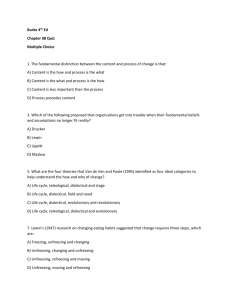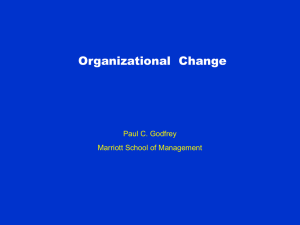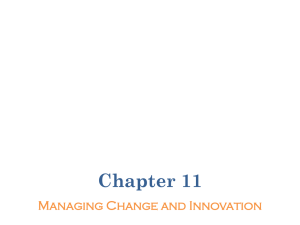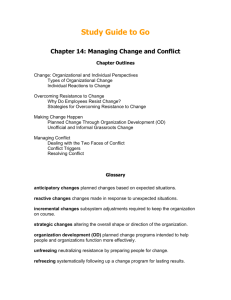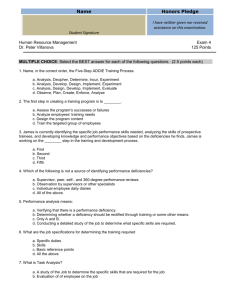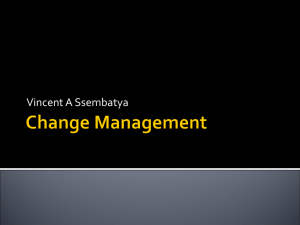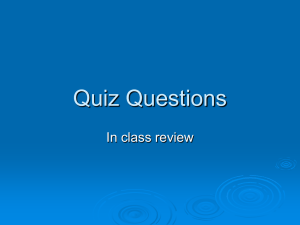ANG Managing Organizational Change
advertisement
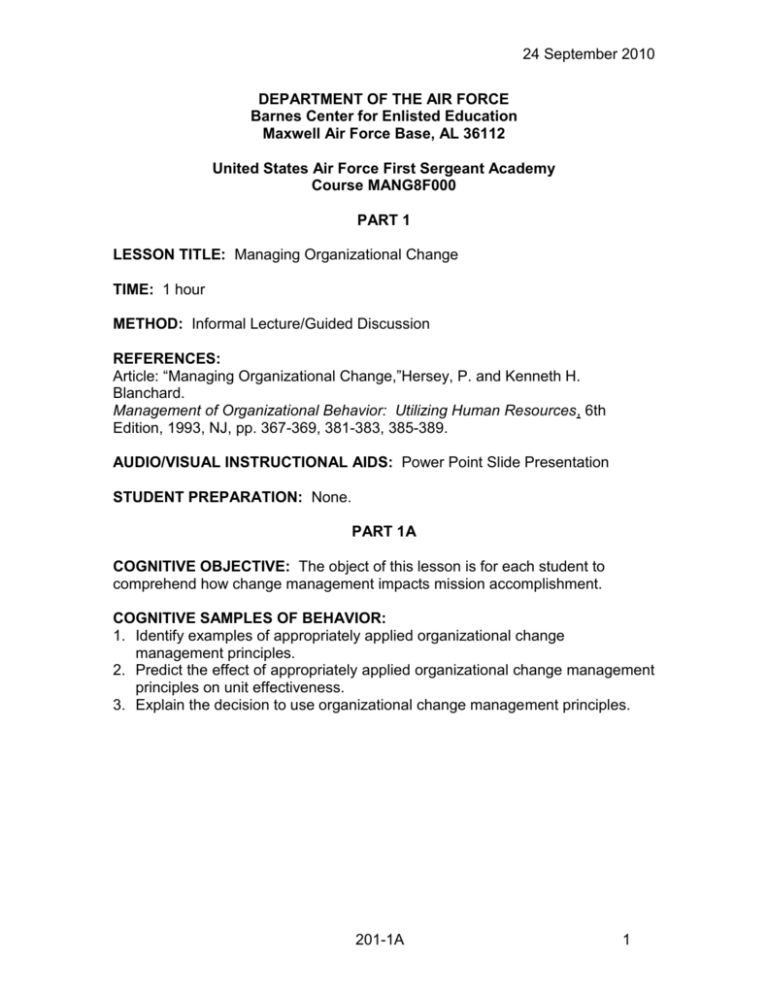
24 September 2010 DEPARTMENT OF THE AIR FORCE Barnes Center for Enlisted Education Maxwell Air Force Base, AL 36112 United States Air Force First Sergeant Academy Course MANG8F000 PART 1 LESSON TITLE: Managing Organizational Change TIME: 1 hour METHOD: Informal Lecture/Guided Discussion REFERENCES: Article: “Managing Organizational Change,”Hersey, P. and Kenneth H. Blanchard. Management of Organizational Behavior: Utilizing Human Resources, 6th Edition, 1993, NJ, pp. 367-369, 381-383, 385-389. AUDIO/VISUAL INSTRUCTIONAL AIDS: Power Point Slide Presentation STUDENT PREPARATION: None. PART 1A COGNITIVE OBJECTIVE: The object of this lesson is for each student to comprehend how change management impacts mission accomplishment. COGNITIVE SAMPLES OF BEHAVIOR: 1. Identify examples of appropriately applied organizational change management principles. 2. Predict the effect of appropriately applied organizational change management principles on unit effectiveness. 3. Explain the decision to use organizational change management principles. 201-1A 1 24 September 2010 PART 1B ORGANIZATIONAL PATTERN: Topical STRATEGY: This is an integral lesson of the Force Management Module. The purpose of this lesson is to provide the students insight into the change process. Change is inevitable, and if not properly managed, can reduce or destroy organizational effectiveness. The lesson provides a means of working through a change process model. SCHEDULING NOTE: This lesson has a written assignment that must be turned in during the second week. Therefore this lesson should be taught as early as possible during Area Two. INSTRUCTOR PREPARATION: Review the lesson references. For further guidance in teaching a lesson with an affective objective, refer to the Guidebook for Air Force Instructors, AFM 36-2236 (particularly Chapters 10, 11, and 14). 201-1A 2 24 September 2010 PART II TEACHING PLAN ATTENTION: Have you ever heard the saying, "Change is inevitable?" or "The only thing constant is change?" Is this true? Recall the changes that have taken place since you joined the service—new aircraft models, policies, procedures, uniforms, etc. For example, remember when the percentage of females in the service started increasing? Do you remember the change in the epaulets for NCOs, double knit uniforms, and so on? The change to an AEF construct? The list goes on and on. Just in your unit you have probably undergone some changes. Recall the most recent change your unit went through. How did you and your people react to the change? Did it all go smoothly? During this course you are hopefully developing a long list of changes that you hope to implement when you get home. In many cases the current way of doing business is deeply imbedded in the organizational culture. In some instances we have done it so wrong for so long that the wrong way of doing business is now seen as the “right” way of doing business. So how do overcome resistance, especially when no one sees a need to change? How do you make sure that a change really takes affect and becomes permanent rather than temporary? How do you get people to “buy-in” to changes that you want to implement? These are all important questions. To be effective you have to be able to apply the knowledge you have. Knowledge + Application = Asset. The problem is not your knowledge, it’s how do you apply it when no one wants to change. Managing Organizational Change is a skill that every leader needs to have, especially first sergeants. MOTIVATION: As senior enlisted leaders, we have to deal with change in our units. We are often the "change Agent," the person charged with making change happen. There are methodical ways to handle change, to manage the process, rather than letting it manage you. This lesson will give you a chance to use a change management model which you can use for making effective changes in your organization. 201-1A 3 24 September 2010 Overview Unfreezing Change Process Refreezing OVERVIEW: Change is really the modification of the unit norms or the adoption of new ideas or behaviors. We’ll first discuss unfreezing or creating a felt need for change. As we cover main point two we will discuss your role as the agent of change…the actual change process. Then finally we will discuss refreezing or locking in the expected norms. TRANSITION: RQ: People in general are so resistant to change, how can we be really effective in creating an environment that is receptive to change? 201-1A 4 24 September 2010 MP 1. Unfreezing MP 1: Unfreezing • Unfreezing refers to creating a felt need for change … It involves preparing the situation • Example: – PT Fitness – AFI 36-2905 prepared Jan 2010 • Implemented 1 July 2010 1(a) Unfreezing is where you create a felt need for change. We begin with a definition of organizational change: the adoption of a new idea or behavior by an organization. In other words, the norms that currently exist in the organization must be changed. These norms can be in many areas of the organization, but we will place them into four main categories. They are technology: computers, test equipment, weapons systems, etc., tasks: general procedures, job steps, checklists, etc, structure: administrative procedures, evaluation systems, etc., or people norms: technical or leadership training, new jobs, etc. (Schemerhorn: 634) No matter what aspect of your organization needs changing, the first step is to recognize the need for change. As the scenario at the beginning of this article indicates, this is not as easy as it seems. Change is needed when there is a perceived gap in what the norms are, and what they should be. This perception sets the platform for the first stage of the change process: unfreezing. Unfreezing is the stage of preparing a situation for change. Here we create a felt need for change. Creating the felt need for change is often the most neglected, yet essential part of unfreezing. A key factor in unfreezing involves making people knowledgeable about the importance of a change, and how their jobs will be affected by it. The people who will be most affected by the change must be 201-1A 5 24 September 2010 made aware of the need for it, in effect making them dissatisfied enough with current operations to be motivated toward change. In many cases, people will want to stick with the old norms; witness the standard response when a change is proposed, "Why do we need to change this? It works just fine the way it is!" As that well-known philosopher Anonymous put it: "Most people hate any change that doesn't jingle in their pockets." The following, points out the first reaction to change: resistance. Just as change is inevitable, so is resistance to change. Planning enables the change agent to anticipate problems, develop courses of action, and to deal with resistance to change. Resistance can take many forms: MP 1: Unfreezing • Forms of Resistance – Uncertainty • Ex. Who’s going to get discharge? – Self-Interests – Different Perceptions, No felt need for change • Ex. Why do we have to change? 1(b) Uncertainty: This may be the biggest cause of people's resistance to change. When faced with an impending change, people may experience a fear of the unknown, or see the change as a threat to their security (Can I do the new job? Can I operate the new equipment? Will I still have a job?). Self-interests: These may involve considerations about the power or role one has in the existing environment, and the possible loss of that power after the change is implemented. Different perceptions or no felt need to change: Even if you think people recognize the need for change, they may have different ideas about the situation. Outwardly, they may support the change, but inwardly, they resist it. 201-1A 6 24 September 2010 Over-determination: Ironically, the structure of the organization may be a barrier to change. For example, a mechanistic structure, which relies on strict procedure and lines of authority, may be so rigid that it inhibits needed change. (Moorhead: 710) The key is to manage and reduce that resistance. Here is where the need for a "change agent", you, becomes vitally important. As senior leaders, it is important that we accept our role as change agents in the management of change. We are in the position of exerting vast influence with our subordinates and superiors. As such, we are often called upon to carry out a change in our organizations, and to "make it happen." There are several methods you can use to reduce and manage resistance: MP 1: UNFREEZING Reducing Resistance –Education and Communication –Participation and Involvement –Facilitation and Support People are our business 1(c) Education and communication: Educating people about the need for, and the expected results of a change should reduce their resistance. Open communication will help reduce uncertainty, and is necessary throughout the change process. Participation and involvement: Resistance may be reduced when those affected by the change are involved in designing it. Involving your people in the process may be time consuming, but should help ensure their commitment to the program. Facilitation and support: Introduce the change gradually if possible, and provide additional training if needed. Reinforce and encourage your people as much as possible, and remember the power of high expectations. 201-1A 7 24 September 2010 MP 1: UNFREEZING Reducing Resistance –Incentives –Coercion Evaluation Standards People are our business 1(d) Incentives: Offer incentives to those who continue to resist the change. Negotiated agreements can be referred to later on if problems should arise. Coercion: This technique involves the use of force to get people to accept change. This should only be used as a last resort, because people's attitudes can be negatively affected, and in the long run, this can result in adverse consequences. (Schemerhorn: 640) Is all resistance to change harmful? Not at all, in fact, people's resistance may be quite logical and bring to light problems in a change proposal that had been overlooked. (Moorhead: 708) Overcoming and managing resistance is an important step in unfreezing, but it is just one of many things that you as a change agent, must be aware of. One technique to help identify all the aspects related to an impending change is to use the Force Field Model. In using this model, you try and decrease OPPOSING FORCES, while you increase SUPPORTING FORCES. There are usually many factors that are either trying to maintain the current norms (the status quo), or trying to change the current norms. The change agent must analyze these restraining (opposing) forces, and devise ways to reduce them, such as overcoming resistance as discussed earlier. At the same time, the driving (supporting) forces, those forces pushing toward change, should be recognized and strengthened. Once the forces for and against change have been analyzed, and a strategy to deal with them has been initiated, you can turn your attention to the change itself. (Griffin: 363; Robbins: 530) Characteristics of the change can increase the likelihood of adoption and implementation. The chances for success are improved when the change can be broken into steps that can be adopted sequentially. Another benefit of this approach is that people who see success at the first step of implementation may be more willing to throw 201-1A 8 24 September 2010 their support behind the rest of the change program. In other words, they may become "drivers", instead of "restrainers." (Daft: 286) The unfreezing stage of change management is really something we should do every time change is imminent. An essential element of unfreezing is careful planning. Careful planning of change, just as with anything else, improves the chances of success while decreasing the likelihood of having to re-accomplishing the unfreezing stage. Your plan should include a set of evaluation standards to measure the degree of success/failure of the change. An objective evaluation with clear goals and objectives can help access the success of change, and help determine appropriate rewards when the change has been completed. TRANSITION: Now, with your plan in place, it's time to move to the next stage of change management: Changing. 201-1A 9 24 September 2010 MP 2. Change MP 2: Changing • Anything that alters the status quo • Movement from the old state, or the previous norms, to the new state Changing involves the actual modification of technology, tasks, structure, or people. This is the movement from the old state, or the previous norms, to the new state. At this time, the new equipment is installed, the restructuring of the organization happens, or a new performance appraisal system is implemented. In short, changing is anything that alters the status quo. What is your role as change agent in this stage? Basically, you monitor the change as it occurs, paying close attention to the people most affected by it. If you've implemented the change too early, you'll know it by watching the people. If some link in the system isn't ready to handle the change, production may bog down, and a few irate callers from other branches or units will let you know in a hurry! In this stage, you ensure that your careful plan unfolds as intended. Even the best plans go awry for one reason or another. Therefore, it's important for you to be there as the change is implemented, so that you can deal with the problems that may arise. You must remember to provide socio emotional support at this stage. The actual implementation of change may be quite traumatic for some, so you should 201-1A 10 24 September 2010 provide encouragement and advice as needed. The same techniques used to overcome resistance that were previously mentioned, are also applicable here. It may be necessary to go back to the unfreezing stage if the change isn't going well. That's all right, because it's better to back up and regroup, than to press on with a change that causes more problems than it fixes. As the change agent, it will be your responsibility to decide whether to move forward. You won't be in a position to make the decision if you're not around keeping tabs on things. Don't just plan the change, flip the switch, and let the chips fall where they may. TRANSITION: Now it's time to move on to the third stage of change management: Refreezing. MP 3. Refreezing MP 3: Refreezing • Locking in Expected Outcomes – Positive Re-enforcement – Evaluate and Monitor – Make Constructive Modifications as Necessary The final stage in the change process is refreezing. Just because the change has been implemented and appears to be going smoothly, doesn't mean the job is done. Here, the desired outcomes or new norms, must be locked in or refrozen, so that they become permanent. Refreezing is necessary, because without refreezing, the old ways of doing things may reassert themselves. For example, many people who attend special 201-1A 11 24 September 2010 training sessions (PME?) apply themselves and plan to use their new skills in their workplace. However, it may be easier just to conform to the old ways rather than make waves. So, the old behaviors take over again, and nothing is changed. If the use of the new techniques is encouraged, the trainee will be more likely to use them; essentially freezing the new behavior. (Moorhead: 717) A key here is evaluation of the results of the change. Did the change have the desired effects? If so, we press on. If not, more support, instruction, training, and additional time, etc., may be called for. You developed strategies to evaluate results in Stage 1 of the change process, so now is the time to use them. It is crucial in this stage to positively reinforce the desired outcomes. Just as with any behavior change, when the people do something right, you reward them. This will strengthen the correct behaviors, helping to "freeze" them in place. In many cases, the change agent can call attention to the success of the change, and show where it does indeed work. This can effectively remove any lingering resistance, and helps prevent things from returning to the old way of doing things. In some cases, even what appears to be successful change management turns out poorly. In one instance, a company bought new computer equipment for the typing pool; replacing the old electric typewriters with word processing stations. The new technology included color monitors, advanced software, high-speed printers, and the works. Everyone was carefully trained, the new equipment was installed, and the supervisors (change agents) provided support and encouragement all the way. Soon the section was turning out professional correspondence in half the time it took previously. Successful change you say, unfortunately it wasn't. To cut down on the noise from the printers, portable dividers were installed between workstations. Where once the typists could converse back and forth unimpeded, they now were cut off and separated from their co-workers. The previous social system, which was one of harmony, turned into one of unhappy isolation. The people suffered, the work suffered, and it was time to regroup. The change plan had to be modified. Do you think the change agents anticipated and planned for this outcome? Probably not, but they really aren't at fault; after all, one can't anticipate everything. The example serves to remind us about the importance of refreezing. The change agent must evaluate results, reinforce the desired outcomes, and make constructive modifications as needed. Think of refreezing this way. Remember the Force Field Model discussed earlier? There you analyzed the positive and negative forces, and manipulated them as needed to reach the desired outcome. This involved moving from the "Where We Are" position, to "Where We Want to be." Now, we want to refreeze at the new position, the new norms, so we manipulate the positive and negative 201-1A 12 24 September 2010 forces to do just that. We have a new "Where We Are" position, and we want to stay there. As a change agent, you have a tough job. By carefully planning change, you can make it as painless as possible. Managing change is one of the most important and rewarding responsibilities you have. Now you have a process which can help you manage the inevitable changes, rather than letting change manage you. One more example from British military history: The Royal Artillery was giving a demonstration to some visiting Europeans in the 1950s. Visitors were most impressed with the speed and precision of the light artillery crew, but one asked about the duty of the man who stood at attention throughout the demonstration. "He's number six," the adjutant explained. "I too, can count, but why is he there?" "That's his job; number six stands at attention throughout." "But then why do you not have five?" No one knew, and it took a great deal of researching through old training manuals, to finally discover his duty. He was the one who held the horses. (Schemerhorn: 635) FUQ: What are the three stages of change? ANTICIPATED RESPONSES: Unfreezing Changing Refreezing FUQ: What is the expected result of the unfreezing process? ANTICIPATED RESPONSES: Creating a felt need for change FUQ: What is the expected result of the freezing process? ANTICIPATED RESPONSES: Locking in new expected norms TRANSITION: Before we conclude the lesson let’s discuss your assignment: 201-1A 13 24 September 2010 United States Air Force First Sergeant Academy Air National Guard Course – Communications Skills Writing Assignment Assignment: Utilizing the information gained from the ANG Course at the USAF First Sergeants Academy, the student will develop a paper on his or her plan for implementing change within their respective units. Papers must be typed. Objective: For the student to develop a “real-world” plan that he or she can utilize after graduation from the First Sergeant Academy. Evaluation: Papers are graded “pass” or “fail”. Each student’s paper will be graded for content and effort only. Effort includes utilizing proper formatting guidelines (see below). Papers must address more than one area of change. Papers should reflect a serious attempt by the author to develop a plan for implementing change within their organization. Requirements: Length: Minimum is two (2) full pages, one-sided, doubled spaced, and typed. Paper must be 8 ½ by 11-inch bond typewriting paper. One ream of paper is provided for students in the student break room. Maximum length of the paper is dictated only by the amount of pages needed to address your plan. Content: The student will identify areas he or she wishes to improve; anticipated resistance; means of coping with resistance; and how he or she plans to implement the change within the organization. Paper Formatting: Student must use a Position Paper format as a guideline for completing the assignment. The Position Paper format is shown in the Tongue and Quill AFH 33-337. Other formats shown within the Tongue and Quill are also acceptable provided the student has approval from the flight instructor. References/Publications/Handbooks: The Tongue and Quill is contained on the CD issued to all students a printed copy of the Tongue and Quill will also be available in the flight rooms. 201-1A 14 24 September 2010 CONCLUSION SUMMARY: This past hour we have discussed Managing Organizational Change. As agents of change, first sergeants are expected to plan and communicate change. We have discussed how to create a felt need for change or the unfreezing process. We discussed changing norms, then refreezing to lock in the new expected norm. SUMMARY Three Stages of Change – UNFREEZING – CHANGING – REFREEZING People are our business REMOTIVATION: Change is inevitable, and you are already good at implementing change. Applying the strategies you used today will make you even more effective at managing change. At some point in time, you will be the change agent responsible for moving your organization toward a better way of doing business. If you use this change model, you can dramatically increase your chance of success when embarking upon a change opportunity. Make a change—the right way CLOSURE: The results of effective change management are clear: change is implemented more smoothly and effectively, members of the organization will respond to the change effort more readily, and in the end a new culture will evolve committed to enhancing unit effectiveness. If we don't implement change carefully, our people will put up barriers that prevent improving the quality of our operations. 201-1A 15
